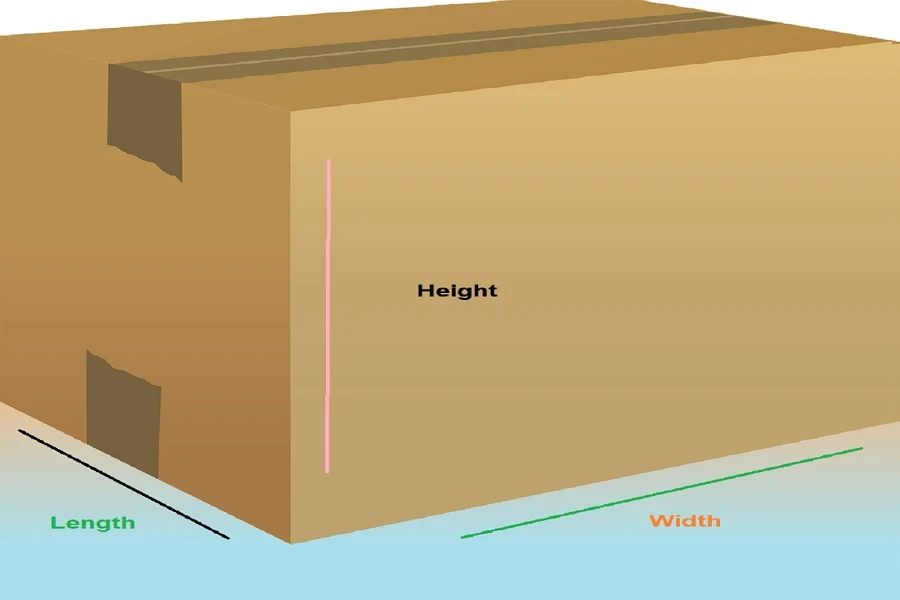Imagine you are importing foam products, which are the items that could constitute higher costs among all supply chain expenses? It might surprise some to discover that shipping costs are among the most significant. Indeed, shipping 1 kg of foam products may often be more expensive than shipping 1 kg of bricks thanks to the principle of CBM, which places greater importance on space over weight and also the nature of volumetric pricing.
To learn more about what CBM is, when it is most applicable, and how to calculate CBM—including how to determine freight costs using CBM—read on to discover the details.
Table of Contents
1. What is CBM
2. When is CBM used
3. How to calculate CBM and the freight costs using CBM
4. Precision for supply chain efficiency
What is CBM

CBM (Cubic Meter) is a volumetric measurement unit used to determine the volume of space occupied by a shipment, focusing on its volumetric weight rather than the actual gross weight. CBM calculations can be applied to various shapes, whether regular or irregular, with special formulas for cylindrical packages. While similar to CFT (Cubic Feet), CBM uses meters as the measurement unit, which is commonly used globally, whereas CFT uses feet and is primarily used in the US.
When is CBM used

From sea freight to truck and air freight, CBM calculation is crucial across different freight modes for maximizing space utilization and the efficiency of shipping costs.
However, in terms of shipping methods, CBM is most useful for Less Container Load (LCL) in sea freight, Less Truck Load (LTL) in truck freight, and consolidated air freight. This is because all these shipping types involve space-sharing with other shippers, where charges are based on the occupied portion of the freight space rather than the actual weight. CBM calculation is extremely valuable in these volume-based shipping methods to determine the total occupied volume or space and subsequently helps in estimating the entire transportation cost.
How to calculate CBM and the freight costs using CBM
How to calculate CBM

In a nutshell, the calculation for CBM can be rather straightforward, simply multiply the parcel’s length (L), width (W), and height (H) together. As for mixed-size cargo which combines various package sizes, perform the CBM calculation for each item size and then sum up all the values to get the grand total. The following is the simple and direct formulas to calculate the total CBM for regular parcels and irregularly shaped packages including cylindrical parcels:
The formula for calculating CBM of regular parcels= L x W x H
The formula for calculating CBM of irregularly shaped packages
= Longest L x Longest W x Longest H
The formula for calculating CBM of cylindrical parcels = π x r² x h, where:
π (pi) is approximately 3.14 (a mathematical constant)
r represents the radius of the cylinder.
h denotes the height of the cylinder.
Key concepts for calculating total freight costs using CBM
Before we can proceed to calculate the entire freight costs using CBM, there are a few important concepts to be taken note of:

- Gross weight: The actual weight of a package, covering everything from any packaging materials to any pallets used.
- DIM Factor: A DIM Factor represents the Dimensional Weight factor, which is the multiplication factor that varies depending on the mode of transportation. It’s worth noting that, however, although there are several standard DIM factors available for different freight modes in the market now, these figures can vary as they are ultimately determined by the freight companies in line with their desired charging rates. Typical DIM Factors for different shipping modes include:
| Freight mode | Typical DIM Factor | Contextual highlights |
| Sea freight | 1:1000 | The different DIM factors here mean that 1 CBM of volume is considered equivalent to 1000, 3000, 6000, or 5000 kilograms (kg) for the purpose of calculating dimensional weight for various shipping modes. Nevertheless, this does not necessarily mean that the higher or lower DIM factor directly represents higher or lower freight rates, as the total rates depend on the per CBM/ton freight rate set for different shipping modes. For example, sea freight typically has a lower per CBM/ton rate compared to air freight and road freight. Therefore, the actual total freight rates are still highly dependent on the per CBM/ton chargeable rate for each mode. |
| Road freight | 1:3000 | |
| Air freight | 1:6000 | |
| Courier/Express freight | 1:5000 |
- Dimensional weight/ volumetric weight: The two terms are interchangeable as they essentially refer to the same thing – the volume-based weight of an item. This method turns shipment volume into a weight equivalent value, from CBM to kg with a fixed DIM Factor as explained above, but via different formulas depending on the freight mode. Common formulas for different freight modes are as follows:
Dimensional weight formula for sea freight= CBM × DIM Factor (1:1000)
| Dimensional weight formula for air freight | CBM × Quantity |
| DIM Factor (1:6000) |
| Dimensional weight formula for road freight | CBM |
| DIM Factor (1:3000) |
- Chargeable Weight: To put it simply, the chargeable weight represents the ultimate choice between gross weight and dimensional weight by the carriers, using the greater of the two as the chargeable weight. This pricing practice ensures that the carriers can receive adequate payment for heavier or space-occupying shipments.
How to calculate total freight costs using CBM

Let’s review the ways to calculate total freight costs using CBM based on different package dimensions for different freight modes, as it’s generally impractical to use a single package dimension and gross weight example across all different freight modes. Sea freight, for example, is typically more suitable for bulkier, heavier items, whereas air freight and road freight may not be as suitable for similar items due to their space constraints and weight limits. The following are examples of total freight rate calculation using CBM for different freight modes. All rates and dimensions are for illustration purposes only; for exact rate charges, consult the relevant freight providers.
- Sea freight

| Illustrative example | |
| Freight rate: | $50 per CBM/ton |
| Package quantity: | 1 |
| Package Dimensions: | Length (L) = 100 cm, Width (W) = 50 cm, Height (H) = 40 cm |
| Gross weight: | 500 Kg |
| DIM factor: | 1:1000 |
| CBM = | 100cm×50cm×40cm | = 0.2 CBM |
| 1,000,000 (1 cubic meter (m³) = 100 cm × 100 cm × 100 cm) |
Total dimensional weight= 0.2 CBM x 1000 (Dim Factor) = 200 Kg (0.2 ton)
Total chargeable weight = gross weight (500Kg) as it is greater than dimensional weight (200 Kg).
Total sea freight rates using gross weight = 0.5 ton x $50 = $250
- Air freight

| Illustrative example | |
| Freight rate: | $250 per CBM/ton |
| Package quantity: | 1 |
| Package Dimensions: | Length (L) = 150 cm, Width (W) = 100 cm, Height (H) = 160 cm |
| Gross weight: | 200 Kg |
| DIM factor: | 1:6000 |
*For air freight, it is standard practice to use cubic centimeters (cm³) directly when calculating dimensional weight since the DIM factor is designed to work with volumes in cm³.
| Total dimensional weight = | Total CBM= 150cm×100cm×160cm = 2400000cm³ x 1 (quantity) | = 400Kg (0.4 ton) |
| 6000 (Dim Factor) |
Total chargeable weight = Since the dimensional weight (400 kg) is greater than the gross weight (200 kg), the chargeable weight is 400 kg.
Total air freight rates using dimensional weight= 0.4 ton x $250 = $100
- Road freight

| Illustrative example | |
| Freight rate: | $60 per CBM/ton |
| Package quantity: | 1 |
| Package Dimensions (cm*): | Length (L) = 120 cm, Width (W) = 90 cm, Height (H) = 50 cm |
| Gross weight: | 150 Kg |
| DIM factor: | 1:3000 |
*For road freight, similar to air freight, most of the time cubic centimeters (cm³) are used directly when calculating dimensional weight.
| Total dimensional weight = | Total CBM= 120cm×90cm×50cm = 540000cm³ | = 180Kg (0.18 ton) |
| 3000 (Dim Factor) |
Total chargeable weight = Since the dimensional weight (180 kg) is greater than the gross weight (150 kg), the chargeable weight is 180 kg.
Total road freight rates using dimensional weight= 0.18 ton x $60 = $10.8
Precision for supply chain efficiency

CBM is a practical, useful, and efficient calculation concept for determining volume-based and space-occupying shipments. It is most useful for LCL (Less than Container Load) and LTL (Less than Truckload) shipments, as it helps to optimize space, calculate costs, and streamline the overall logistics process. Such precision is essential for supply chain efficiency and cost-effectiveness.
To make full use of CBM formulas to calculate the total freight costs of a shipment, one must gain an understanding of the CBM concept, gross weight, DIM Factor, dimensional weight, and chargeable weight. Through CBM formulas and fixed DIM factor determination, freight providers manage to implement a pricing technique that can cater to both their weight limitations and space concerns.
Visit Alibaba.com Reads often for more logistics knowledge, wholesale business insights, and sourcing recommendations while staying updated on the latest trends and advancements in global shipping.

Looking for a logistics solution with competitive pricing, full visibility, and readily accessible customer support? Check out the Alibaba.com Logistics Marketplace today.



